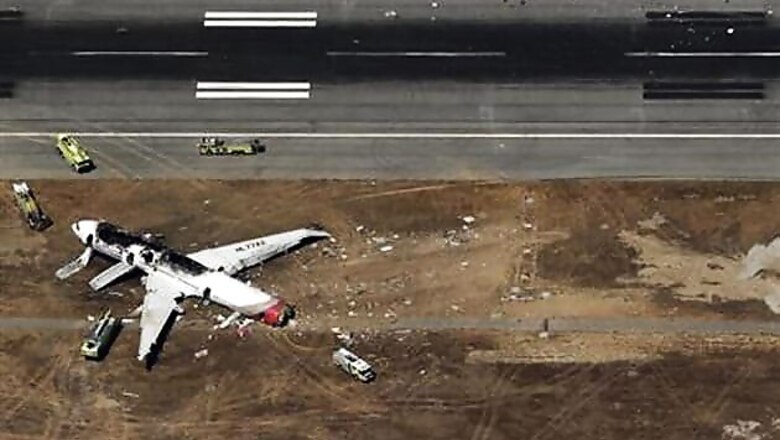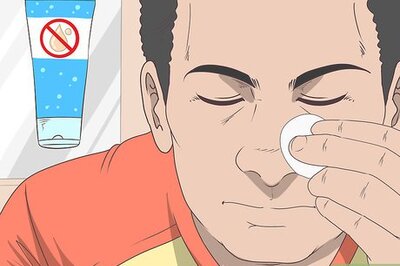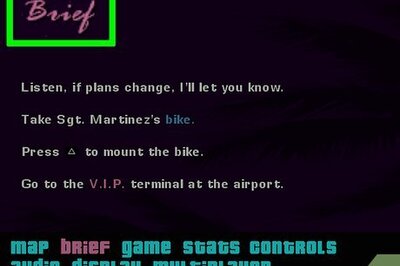
views
US officials examined flight information recorders and began investigating the crash of an Asiana Airlines Boeing 777 that burst into flames upon landing in San Francisco, killing two teenaged Chinese students and injuring more than 180 people, officials said on Sunday.
There was no immediate indication of the cause of Saturday's accident but Asiana said mechanical failure did not appear to be a factor. The airline declined to blame either the pilot or the San Francisco control tower.
Eric Weiss, a spokesman for the National Transportation Safety Board, said the plane's "black boxes" - the cockpit voice recorder and flight data recorder - had been recovered and were sent to Washington for analysis. The Federal Aviation Administration also was investigating and Asiana Airlines said on Sunday that Korean accident investigators were on their way to San Francisco.
NTSB Chairman Deborah Hersman said on Sunday there was no indication of a criminal act but it was too early to determine what went wrong.
"Everything is still on the table," she said on NBC's "Meet the Press."
Investigators in coming days will interview the pilots and look at data from the black boxes, radar equipment and other information to determine the cause of the crash, she said in an interview on CNN's "State of the Union."
"It's really important to put all of the pieces of the puzzle together," Hersman said.
The plane was coming in from Seoul when witnesses said its tail appeared to hit the approach area of a runway that juts into San Francisco Bay. One witness said the plane appeared to be coming in too low and too fast.
The impact knocked off the plane's tail and the aircraft appeared to bounce violently, scattering a trail of debris before coming to rest on the tarmac.
SERIOUS INTERIOR DAMAGE
Pictures taken by survivors showed passengers hurrying away from the wrecked plane. Thick smoke billowed from the fuselage and TV footage later showed the aircraft gutted and blackened by fire. Much of its roof was gone.
Interior damage to the plane also was extreme, Hersman said on CNN.
"You can see the devastation from the outside of the aircraft, the burn-through, the damage to the external fuselage," she said. "But what you can't see is the damage internally. That is really striking."
The dead were identified as Ye Meng Yuan and Wang Lin Jia, both 16-year-old girls and described as Chinese nationals who are students, Asiana Airlines said. They had been seated at the rear of the aircraft, according to government officials in Seoul and Asiana.
The crash was the first fatal accident involving the Boeing 777, a popular long-range jet that has been in service since 1995. It was the first fatal commercial airline accident in the United States since a regional plane operated by Colgan Air crashed in New York in 2009.
"For now, we acknowledge that there were no problems caused by the 777-200 plane or (its) engines," Yoon Young-doo, the president and CEO of the airline, told reporters on Sunday at the company headquarters on the outskirts of Seoul.
Asiana on Sunday said the flight, which had originated in Shanghai, had carried 291 passengers and 16 crew members. The passengers included 141 Chinese, 77 South Koreans, 64 US citizens, three Indians, three Canadians, one French, one Vietnamese and one Japanese citizen.
Dale Carnes, assistant deputy chief of the San Francisco Fire Department, said 49 people were hospitalized with serious injuries. Another 132 suffered moderate and minor injuries.
Five people were in critical condition at San Francisco General Hospital, according to spokeswoman Rachael Kagan. She said a total of 52 people were treated for burns, fractures and internal injuries. Three people were critical at Stanford Hospital.
TOO LOW, TOO FAST
Survivor Benjamin Levy told a local NBC station he believed the Asiana plane had been coming in too low.
"I know the airport pretty well, so I realized the guy was a bit too low, too fast, and somehow he was not going to hit the runway on time, so he was too low ... he put some gas and tried to go up again," he said in a telephone interview.
"But it was too late, so we hit the runway pretty bad, and then we started going up in the air again, and then landed again, pretty hard."
Levy said he opened an emergency door and ushered people out. "We got pretty much everyone in the back section of the plane out," he said. "When we got out there was some smoke. There was no fire then. The fire came afterward."
Vedpal Singh, a native of India, was on board the flight along with his wife and son when the aircraft struck the landing strip.
"Your instincts take over. You don't know what's going on," said Singh, who had his arm in a sling as he walked through the airport's international terminal and told reporters he had suffered a fractured collar bone.
Asiana, South Korea's junior carrier, has had two other fatal crashes in its 25-year history.
A senior Asiana official said the pilot was Lee Jeong-min, a veteran pilot who has spent his career with the airline. He was among four pilots on the plane who rotated on two-person shifts during the 10-hour flight, the official said.
A San Francisco airport spokesman said that a component of the facility's instrument landing system that tracks an incoming airplane's glide path was not working on Saturday.
Pilots and air safety experts said the glide path technology was far from essential for a safe landing in good weather.


















Comments
0 comment